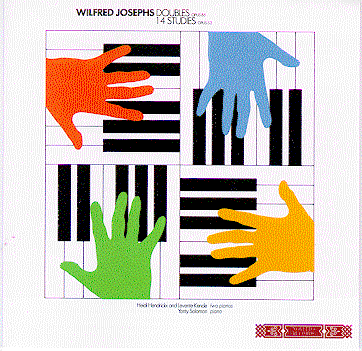
| Novello Records NVLCD104
Doubles Op. 85
Heidi Hendrickx and Levente Kende,
Fourteen studies Op. 53 Yonty Solomon, piano |
Chairman: Matthew Eve

| Novello Records NVLCD104
Doubles Op. 85
Heidi Hendrickx and Levente Kende,
Fourteen studies Op. 53 Yonty Solomon, piano |
| Like Berlioz, whose observation of the inanities perpetrated by virtuoso composers prompted him to express relief at his own lack of
keyboard facility, Wilfred Josephs is anything but a fluent pianist. At one time he regarded the piano as an alien medium. But in
1963 the Canadian pianist Neil van Allen asked him to write a solo work. The request, which resulted in the Second Piano Sonata,
Op. 40, forced Josephs into a new, stimulating rapprochement with the instrument. The First Piano Concerto followed in 1965;
and by 1966, when the Fourteen Studies were written "for Rhondda Gillespie, Jay Blech, and Yonty Solomon," no suspicion of
unease remained in the composer's handling of the piano. Reviewing Rhondda Gillespie's 1967 world premiere of the complete
set at the Cheltenham Festival, the Daily Telegraph critic Peter Stadlen - himself a pianist of some stature - remarked that it was
"refreshing to encounter some pieces that have been invented straight out of the instrument. New slants," he went on to say, "are
offered an venerable problems, diatonic thirds, leaps, but new problems are broached, too." The combination of fresh ideas with a fruitful relation to tradition could well stand as a capsule definition of Josephs's stylistic approach over the years, though it is only relatively recently that his achievement has begun to catch up with his potential, and his reputation with his achievement. Works that he wrote as far back as the mid-1950s show a composer with an already recognizable personality, but one not yet emancipated from the fairly innocuous style endemic in Britain at the time. For Josephs a wider perspective opened when he won a Leverhulme Scholarship in 1958. Technically well prepared by his studies with Arthur Milner in Newcastle and with Alfred Nieman at the Guildhall School in London he went now to Paris for a year to study with Max Deutsch, and the issue of 12-note serialism was joined in earnest. Maitre Deutsch was himself a distinguished Schoenberg pupil. His teaching clearly helped the young composer to assimilate the lessons of the Second Viennese School and to come out, as it were on the other side, at a time when few of his compatriots had ventured beyond the boundaries of the familiar English pastoral-historical-tragical manner. Like other Josephs works of the 1960s, the Fourteen Studies combine an arrestingly individual use of techniques derived from serialism with a new freedom from the grip of 12-note chromaticism. The composer provided the following brief description for the premiere.
No.1 - Vivo leggiero: In 3/16 time. Mainly soft, but with some outbursts. In the gradual shift of contemporary music back to practices once regarded as seditious - the expressive use of tonal harmony, and particularly, the writing of real tunes - it was natural that a composer blessed with Josephs's outstanding melodic gift should soon have found himself in the vanguard. To this resource, supported as it was by the constructive underpinning of his serial legacy, the music of his maturity has added two other especially fertile lines of interest. Works like the choral and orchestral Mortales of 1967-9 and the masterly Fourth Symphony of 1967-70 began to explore the integration of stringently controlled aleatoric elements into a musical language that otherwise remained fully determinate. Meanwhile, the 1965 Canzonas on a Theme of Rameau proved prophetic in two respects. It proved to be one in a series of works that have derived a world of illuminating and touching allusiveness from their retrospective evocations of various pre-existing musics (works like the seventh and ninth symphonies. Tombeaux for organ, and the String Quartet No.4 composed in honour of Haydn's 25Oth birthday in 1982). More specifically, Canzonas was a first homage to the French baroque composer who was to be featured alongside Mazart in what is probably the finest of all Josephs's now numerous keyboard works: Doubles, composed between 1970 and 1973, and subtitled "Twice 22 doubles on 2 themes by 2 composers for 2 pianos." As the composer has noted, the piece is full of double entendres, beginning with the title itself, since "doubles" is an old-fashioned term for variations. The two themes are taken from Mozart's A minor Rondo for piano, K. 511, written in 1787, and from Rameau's La Poule (The Hen), the most famous piece in his Nouvelles Suites de Pièces de Clavecin of c. 1728. A section-by-section roadmap of the music would be merely confusing, since many of the variations flow into each other without sharp demarcation. At first presented independently, the two themes soon begin to take on aspects of each other's colouring. By the end, both have been illuminated by all kinds of revealing interactions, and a number of other composers have also passed in review. Josephs acknowledges here the influence of his younger English contemporary Robin Holloway: "I'd got to know Holloway's Schumann pieces just when I was working on Doubles, so when a tune wanted to turn into Over the Sea to Skye or the Hammerklavier or the Debussy Cakewalk I didn't stop it - I just let it happen". The method may sound casual, but the music doesn't, for Josephs' wit and invention never flag. Once again, as with many fine works through the history of music, a creative attitude to the past spells a serene originality in the present.
Bernard Jacobson |
 Classical Music on the
Web
Classical Music on the
Web